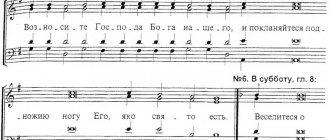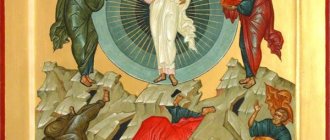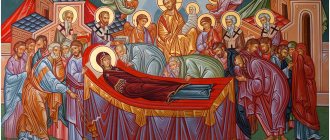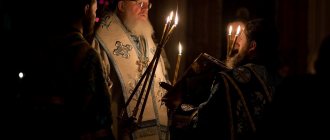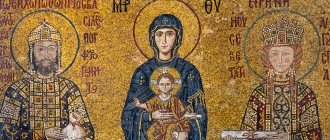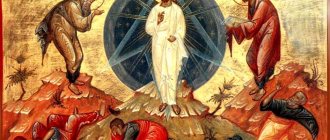Transfiguration of the Lord: festive antiphons, troparion and kontakion
First antiphon:
Verse 1 (Psalm 65): Shout to the Lord, all the earth, / sing to His name, give glory to His praise. Chorus: Through the prayers of the Mother of God, Savior, save us. Verse 2 (Psalm 76): The voice of Your thunder is in the wheels, Your lightning illuminates the world: / the earth moves and trembles. Chorus: Through the prayers of the Mother of God, Savior, save us. Verse 3 (Psalm 103): You are clothed with confession and sweat,/ clothed with light like a robe. Chorus: Through the prayers of the Mother of God, Savior, save us. Glory to the Father and the Son and the Holy Spirit/ now and ever and unto ages of ages. Amen. Chorus: Through the prayers of the Mother of God, Savior, save us.
(download)
GntifHn No.:
Article no. Ral0m…є: Shout out to all the earth,/ sing to the name of є3гw2, give Glory to the Praise of є3гw2. With your prayers btsdy, sp7se, save2 us. Stjхъ в-th. Ral0m o7ѕ: The voice of your thunder in the wheels2, the light of your universe, / the movement and3 trembling presence of the earth. With your prayers btsdy, sp7se, save2 us. Stjхъ G-th. Ral0m Rg: In response and 3 in the great light њbleklсz є3сi2,/ њедесйсz light ћкw р1зу. With your prayers btsdy, sp7se, save2 us. Glory, and3 nhne: With your prayers, bcd, save2 us.
Second Antiphon:
Verse 1 (Psalm 47): The mountains of Zion, the ribs of the north, / the city of the Great King. Chorus: Spasiny, Son of God, transfigured on the mountain, singing Ti: alleluia. Verse 2 (Psalm 77): And I brought into the mountain His holy thing,/ this mountain, which His right hand possessed. Chorus: Spasiny, Son of God, transfigured on the mountain, singing Ti: alleluia. Verse 3: You loved Mount Zion and made your sanctuary like a unicorn. Chorus: Spasiny, Son of God, transfigured on the mountain, singing Ti: alleluia. Glory, even now: the Only Begotten Son...
(download)
GntifHn v7:
Article no. Ral0m m7z: Mountains sіHnskіz, ribs of the north, / city tsrs vel1kagw. Savi1 us, sn7e b9іy, transform1vyysz on the mountain, singing 12: Hallilya. Stjхъ в7. Ral0m o7z: And# enterE | in g0ru s™hni svoeS,/ g0ru sіyu2, yu4he stzhA desnitsa є3гw2. Savi1 us, sn7e b9iy, transform1vyysz on the mountain, singing 12: Hallilya. Stjхъ G: G0ru sіHnyu, yu4he love2, and3 created,/ ћкw є3dinor0ga with™i1lish yours. Savi1 us, sn7e b9iy, transform1vyysz on the mountain, singing 12: Hallilya. Slava, and3 nhne: E#dinor0dny sn7e:
Third Antiphon:
Verse 1 (Psalm 124): Those who trust in the Lord are like Mount Zion; they will not move forever. Troparion: You were transfigured on the mountain, O Christ God... Verse 2: The mountains are around him, and the Lord is around his people from now on and forever. Troparion: Thou art transfigured on the mountain, O Christ God... Verse 3 (Psalm 14): Lord, who dwells in Thy dwelling? Or who will dwell in Your holy mountain? Troparion: You were transfigured on the mountain, O Christ of God... Verse 4 (Psalm 23): Who will ascend to the mountain of the Lord? or who will stand in the place of His saints? Troparion: You were transfigured on the mountain, O Christ of God...
GntifHn G, voice з7:
Article no. Ral0m rk7d: Nadeyushchiisz on the city, ћkw mountain A siHn, does not move forever. Troparion: Transformation on the mountain: Stjkh v7: Mountains cross є3гw2 and 3 gDь џcross their people 1хъ t Ннне и3 to the century. Troparion: Transformation on the mountain: Stjkh G. Ral0m d7i: GDi, who2 kills in your dwelling; and3or2 who2 will live in your s™y city2; Troparion: Transformation є3сi2 on the mountain: Stjхъ d7. Ral0m k7g: Who2 climbed the mountain; and3or2 who2 will stand in place with™yom є3гw2; Troparion: Transfiguration є3сi2 on the mountain:
Troparion, tone 7:
Thou art transfigured on the mountain, O Christ God, / showing to Thy disciples Thy glory, / like man, / may Thy ever-present light shine upon us sinners / through the prayers of the Mother of God, // Light-giving, sweet wa to you.
(download)
Troparion, voice 37:
Transformation on the mountain, xrte b9e,/ showing your6m your glory2,/ as may:/ may our sinners rise up/ your everlasting light,/ through your prayers, // the day before, sla wa you.
Kontakion, tone 7:
You were transfigured on the mountain, / and like your disciples, / you saw your glory, O Christ God, / so that when they see you crucified, / you will understand your free suffering, / you will preach to the world They say that you are truly the Father’s radiance.
(download)
Kontakion, voice 37:
On the mountain of transformation є3сi2,/ and 3 ћskin in the place ў§2 yours2,/ thy glory2, хрте b9е, 11desh:/ yes є3 where we are crucified,/ the suffering ќбw ўunderstand free,/ mjrovi about tell // ћкw you2 є3сi2 truly џ§ee sisnie.
Author: Administrator
Publication date: 08/05/2019
Responses (426)
You must be logged in to leave a response.
Transfiguration of the Lord God and our Savior Jesus Christ
In the Orthodox calendar, this holiday is called “ Transfiguration of the Lord God and our Savior Jesus Christ ” and is now celebrated on August 19. For many literature lovers, he is associated with the wonderful poems of Boris Pasternak.
You were walking in a crowd, separately and in pairs, Suddenly someone remembered that today is the sixth of August in the old days, the Transfiguration of the Lord.
Usually light without flame comes from Tabor on this day, and autumn, clear as a sign, attracts your eyes!
These poems express the mood of the holiday - so aristocratically refined and brilliant. In the folk calendar, which is overly concerned with culinary problems, it is called the Second, or even Apple, Savior.
Let's start with the first level of studying this calendar phenomenon - by clarifying the meaning of the Gospel event of “transfiguration” itself. What does this term itself mean? What event of Sacred history and why received such a name?
Transfiguration: event and meaning
Transfiguration (Greek metamorphosis, Latin transfiguratio) means “transformation into another form,” “change in form” (hence “metamorphosis”). This is the name of one of the most important events in gospel history, which occurred shortly before the last Easter of Jesus Christ. Three evangelists talk about him: Matthew 17:1-13, Mark 9:2-13 and Luke 9:28-36.
Eight days after the solemn confession of St. Peter, his Teacher, the Messiah (Christ), writes the Evangelist Luke, Jesus, “taking Peter, John and James with Him, went up to the mountain to pray. And during prayer, His face suddenly changed, and His clothes became sparkling white. And two people talked with Him - these were Moses and Elijah, who appeared in the radiance of heavenly glory. And they talked about the exodus that He was about to accomplish in Jerusalem.
And Peter and his companions fell asleep, and when they woke up, they saw the radiance of His glory and two men standing next to Him. And when they were about to leave Him, Peter said to Jesus: “Master, how good it is for us to be here! Let us set up three tents here: one for You, one for Moses and one for Elijah!” “He himself didn’t know what he was saying,” Luke notes and continues. “And before he even finished speaking, a cloud appeared and covered them with its shadow. The disciples, finding themselves in the cloud, were afraid. But a voice came from the cloud, saying: “This is My chosen Son, listen to Him!” And when the voice ceased, it turned out that Jesus was alone. The disciples kept it a secret and did not tell anyone at that time what had seen” (Luke 9:28-36).
And Evangelist Mark clarifies: “When they descended from the mountain, Jesus commanded that they should not tell anyone about what they had seen until the Son of Man rose from the tomb. They did this, but they interpreted among themselves: “What does it mean to rise from the grave?”” (Mark 9:9-10).
The historical and theological meaning of this important episode of Sacred History is clear. Let us remember that not only the common people, but even the disciples considered Jesus Christ primarily an earthly king-warrior. And the false messianic illusions persisted among the apostles even after His Ascension, right up to Pentecost! Therefore, the Lord lifts the curtain of the future for them and reveals Himself as the Son of God, the ruler of life and death. He assures his disciples in advance that the coming suffering is not defeat and shame, but victory and glory, crowned by the Resurrection.
At the same time, Christ resorts to the judicial rule formulated in the Law of Moses: “At the words of two witnesses... every thing will take place” (Deut. 19:15). By this He legally refutes the absurd accusations made by the scribes and Pharisees of his violation of Jewish law. Calling as “witnesses” the Lawgiver himself (!) and the formidable prophet Elijah, who speak with Him about His “exodus” to death and Resurrection, Christ certifies the apostles in the agreement of His work with the Law of Moses. He hopes that at least his closest students will not succumb to despair, but will themselves become a support for those who doubt. This is the meaning of the event being celebrated.
On holiday icons, Jesus usually appears in a halo of “Taborian light” - the radiance that appeared to the apostles. To the left and right of Him are Elijah and Moses, who is holding in his hands the “Tablets of the Covenant” - stone tablets with the ten most important laws. At their feet are the apostles, fallen on their faces and covering them with their hands from the unbearable light rushing towards them in the form of broken rays.
Transfiguration: a single event and an annual celebration
But when did the event of transfiguration itself take place - was it really at the end of summer, and not before the Savior’s suffering on the cross, as is clear from the logic of the Gospel narrative?
Outstanding Russian historian, prof. St. Petersburg Theological Academy V.V. Bolotov convincingly proved that Christ was transfigured before his disciples shortly before His last Easter, in February or March according to our calendar. At the same time, analyzing the history of several holidays, he shows that in establishing calendar dates for its celebrations, the Church was sometimes guided by “pedagogical” (missionary) considerations. By fixing holidays deliberately on the days of pagan celebrations, the Church wanted to overcome local traditions and remnants of previous religious customs.
This happened with the Feast of the Transfiguration. Previously, according to V. Bolotov, it was established in Armenia and Cappadocia to replace the local veneration of the pagan goddess Astghik (analogous to the Greek Aphrodite) and fell on the sixth week after Easter.
This “missionary” logic was also relevant in other countries. Thus, in Greece and Italy, the end of the grape harvest was accompanied for a long time by pagan “bacchanalia” - a cheerful holiday in honor of the intoxicating god Bacchus. In order to oust it from everyday life (or “Christianize”), it was decided to celebrate the “Transfiguration” at this time, artificially combining with it a thanksgiving prayer to God for the bestowal of “earthly fruits.” (It was possible to gather the maximum number of villagers, especially those living in distant mountainous regions, in the church only on major holidays.) This is a continuation of the Old Testament custom of blessing the “firstfruits” - the first fruits. In Constantinople, the holiday was established only under Emperor Leo the Philosopher (886–912), and it was fixed in the fixed, menain calendar (the reason for the origin of the date on August 6 is still in question). And from the Byzantines it passed to the Slavs.
It is interesting that this holiday, oriental in origin, appeared in the West quite late. Here Festum Transfigurationis Christi, as it is called in the Catholic calendar, was not universal for a long time. Only in 1457 did Pope Callixtus III make it universal and establish a rite of worship for it. Moreover, this was done in memory of the important victory of the Christian army gathered by St. John Capistran, over the Turks on August 6, 1456. As a result, the siege of Belgrade was lifted and Turkish expansion into Western Europe was stopped.
In the Orthodox Church, the Transfiguration has the status of the twelfth holiday. In the Catholic Church, its liturgical rank is lower and corresponds to the holidays in honor of the apostles and evangelists. Lithuanian philosopher and theologian Antanas Maceina wrote in this regard: “The basis for the emergence of the holiday in the East is theological: these are the reflections of writers and fathers of the Greek Church about God as Light, which shines in the depths of existence and therefore a person can not only feel Him, but sometimes even see clearly. In the West, the incentive to celebrate it was of a public nature.”
Fine! – the impatient reader will exclaim. – These are theological subtleties! But what do apples have to do with it?! Everything is very simple.
Indeed, the “Prayer at the Communion of the Cluster on the 6th day of August” prescribed by the Church Charter speaks only of the blessing of the “new fruit of the vine” (grapes). But, having borrowed from the Greeks the calendar of holidays and accompanying rituals that were formed in the Mediterranean region, the Russians inevitably had to “violate” the charter and replace grapes with apples - the main fruits of the North. Hence the strange, albeit euphonious name of the holiday - “Apple Savior”, which has nothing to do with its theological and historical basis.
See also: Transfiguration of the Lord. The event of the holiday and its eorthological dynamics. Bitbunov G.S.
For curious readers:
Bolotov V.V. Mikhailov day. Why is the Cathedral of St. Archangel Michael takes place on November 8th? (Eortological study) // Christian Reading. 1892. No. 11-12. pp. 616-621, 644; Dmitrievsky A. A. Feast of the Transfiguration of the Lord on Mount Tabor. St. Petersburg, 1913; Ruban Yu. “Light without flame” // “Living Water”. St. Petersburg Church Bulletin. 2007. No. 8.
Feast of the Transfiguration of the Lord: history and meaning
It is difficult to name the exact date of the Transfiguration as a church holiday. There is an opinion that it was established by Equal-to-the-Apostles Helen, the mother of Emperor Constantine the Great, in the 4th century. She built a temple on Mount Tabor in honor of the Transfiguration of the Lord. Among scientists there is an opinion that the holiday was established later, in the 5th - 6th centuries in Armenia and Cappadocia. But the first version is traditional and more common.
From the Gospel it is clear that the Transfiguration of the Lord took place forty days before the crucifixion of the Savior. That is, at the end of February - beginning of March. Then why do we celebrate the Transfiguration on August 6 (19)?
This is due to the spread of Orthodoxy and the missionary movement. The Church, spreading across pagan lands, tried to replace ancient pagan holidays with Christian ones. At the same time, elements of the external design of the celebration were retained, but the essence was completely changed. This happened with the Feast of the Transfiguration.
When Christianity came to Greece, the Transfiguration of the Lord was placed at the site of a celebration in honor of Dionysus, the god of wine and winemaking. The only external paraphernalia left is the consecration of bunches of grapes in the church. And when Orthodoxy came to Rus' from Byzantium, grapes were replaced with apples, which mainly grew on our territory, and other fruits. So the holiday of the Transfiguration of the Lord received a second, everyday name - Apple Savior.
Transformation - what is it?
The Feast of the Transfiguration of the Lord was established in memory of the change in the appearance of Jesus Christ on Mount Tabor before his three disciples: Peter, James and John. This event is described in three Gospel texts - (Matthew 17: 1–6); (Mark 9:1–8); (Luke 9:28–36).
The tradition of celebrating the Transfiguration of Christ on Mount Tabor belongs to Queen Helen Equal to the Apostles (c. 250-330 AD), mother of the Roman Emperor Constantine the Great (Constantine Equal to the Apostles). This place was not chosen by chance; Mount Tabor is a real decoration of the Holy Land. She witnessed many key events in the history of the Israeli people. However, some researchers point to other places where the Transfiguration could have occurred.
Transfiguration of the Lord (Russian Orthodox icon, 15th century)
Features of the festive service
Transfiguration is the twelfth holiday, so the service on this day is solemn. At the evening service, lithium is served and the consecration of the loaves is performed. The Great Prokeimenon, holiday chants and the Transfiguration Canon are sung. At the Liturgy, antiphons and troparia are also festive. Instead of “It is worthy to eat,” the honor of the holiday is performed. From the day of the Transfiguration until the celebration of the holiday, the clergy wear white vestments.
The main feature of the holiday is the rite of blessing the fruits. Usually parishioners bring with them baskets with various fruits. After the prayer behind the pulpit, the priest sanctifies them by sprinkling them with holy water. The rite of blessing the fruits symbolizes the lifting from nature of the seal of the curse that fell on the entire earth with the Fall of man.
What does the Transfiguration of the Lord mean?
The Savior was transformed, showing His glory to the disciples to encourage them, to give them hope and spiritual strength to survive the three days when He would be dead. After all, even then the disciples perceived him as a prophet, king, messenger of God, but not the Son of the Lord. The voice of the Holy Spirit that sounded from heaven was another sign that revealed to the disciples all the power and authority of their Teacher.
When we read the Gospel, we are often perplexed: why do the disciples not understand the meaning of the parables and some of the words of the Savior? The whole point is that we already know that He is the Son of God. We already understand the general meaning of His allegories. Until the last moment, the apostles did not understand the full meaning of what was said and what was happening. It had not yet been revealed to them with all clarity and evidence that Jesus Christ is the Son of God.
The appearance of the two prophets also has a deep meaning. Moses, the leader and legislator of the people of Israel, bows his head before Jesus Christ. This means that He is the founder of the Old and New Testaments. And Elijah, a zealous prophet who punishes blasphemers and heretics, humbly listens to the Savior, confirming that He is the long-awaited Messiah.
On the icons of the Transfiguration of the Lord, the Savior is depicted standing on Mount Tabor. On his sides are the prophets, and at his feet are the apostles, who fell to the ground and covered their faces from the uncreated light emanating from Christ. Later icons show angels accompanying Jesus and the prophets, and additional elements revealing details of the event.
The significance of the Feast of the Transfiguration of the Lord is great not only for the disciples of Christ, but also for modern Orthodox Christians. The holiday personifies the renewal and purification of human nature with God's help. Since ancient times, the Transfiguration has been loved by Russian people. In honor of this holiday, churches and monasteries were built, the celebration was always solemn and crowded.
Events that formed the basis of the holiday
Christ, taking three disciples, ascended the mountain. Obviously the climb was difficult. Tired of the journey, the disciples fell asleep. During their sleep, Jesus was transformed:
“And as He prayed, the appearance of His face changed, and His clothes became white and shining” (Luke 9:29).
When the disciples woke up, they saw the Lord talking with two prophets - Moses and Elijah. Bright light and divine grace emanated from Christ. From the joy that spread around, Peter wanted to stay on Mount Tabor forever. He invited the Lord to create three tabernacles (tents, temporary dwellings) - for Him and the two prophets.
“While He was still speaking, behold, a bright cloud overshadowed them; and behold, a voice from the cloud, saying: This is My beloved Son, in whom I am well pleased; Listen to Him” (Matthew 17:5).
The students got scared and fell to the ground, covering their faces with their hands. And all the Glory of the Lord and His prophets disappeared. When the disciples stood up, they saw only Jesus Christ.
When the Lord descended with the disciples from Mount Tabor, He commanded them to remain silent about the vision that had been revealed to them. Be silent until He rises from the dead. Theologians believe that with this miracle Jesus Christ wanted to encourage and support His disciples, who did not want to let Him go to a voluntary sacrificial death. By His Transfiguration, Christ clearly showed the apostles his divine nature. And through the appearance of two Old Testament prophets, he confirmed that his future Death on the Cross is the fulfillment of ancient prophecies about the Messiah.
